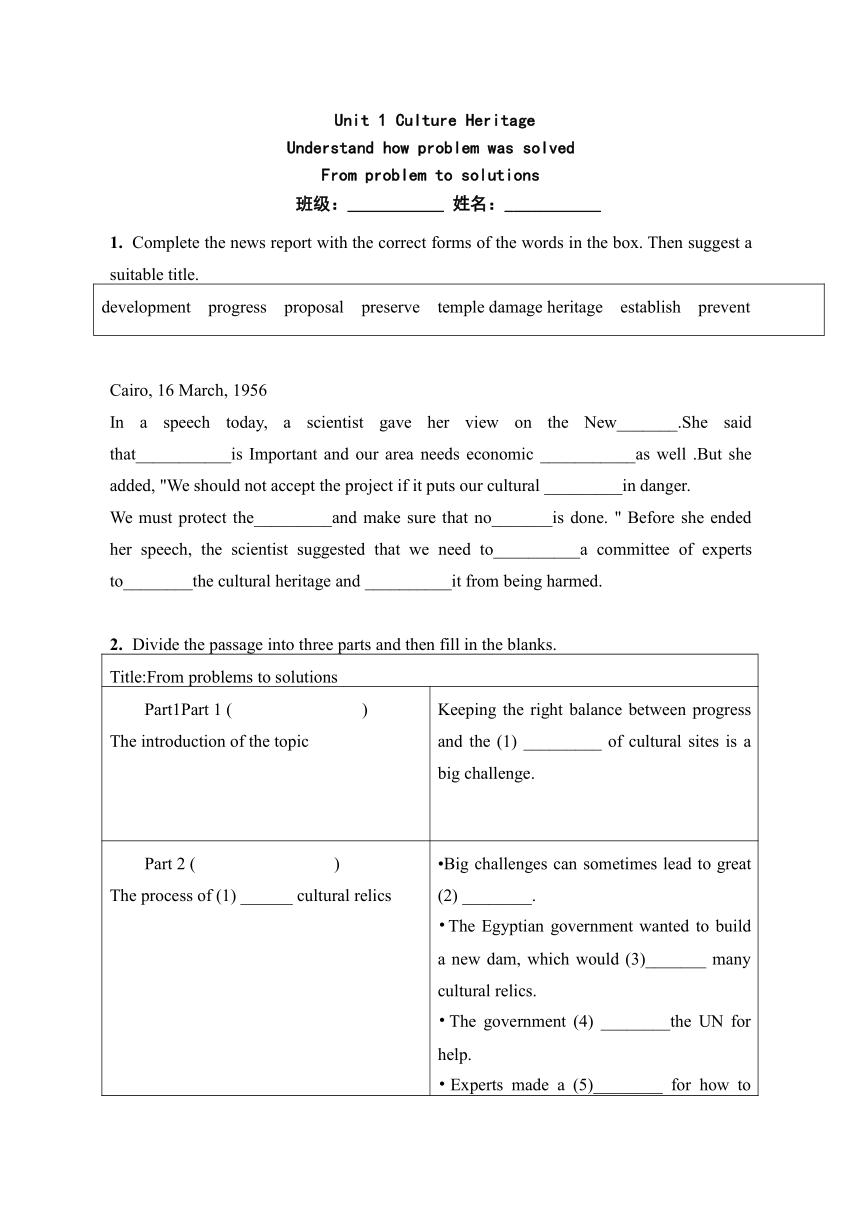人教版(2019)必修第二册Unit 1 Cultural Heritage Reading and Thinking 学习任务单学案(无答案)
文档属性
| 名称 | 人教版(2019)必修第二册Unit 1 Cultural Heritage Reading and Thinking 学习任务单学案(无答案) |  | |
| 格式 | docx | ||
| 文件大小 | 17.4KB | ||
| 资源类型 | 教案 | ||
| 版本资源 | 人教版(2019) | ||
| 科目 | 英语 | ||
| 更新时间 | 2024-03-14 18:25:03 | ||
图片预览

文档简介
Unit 1 Culture Heritage
Understand how problem was solved
From problem to solutions
班级:___________ 姓名:___________
Complete the news report with the correct forms of the words in the box. Then suggest a suitable title.
development progress proposal preserve temple damage heritage establish prevent
Cairo, 16 March, 1956
In a speech today, a scientist gave her view on the New_______.She said that___________is Important and our area needs economic ___________as well .But she added, "We should not accept the project if it puts our cultural _________in danger.
We must protect the_________and make sure that no_______is done. " Before she ended her speech, the scientist suggested that we need to__________a committee of experts to________the cultural heritage and __________it from being harmed.
Divide the passage into three parts and then fill in the blanks.
Title:From problems to solutions
Part1Part 1 ( ) The introduction of the topic Keeping the right balance between progress and the (1) _________ of cultural sites is a big challenge.
Part 2 ( ) The process of (1) ______ cultural relics Big challenges can sometimes lead to great (2) ________. The Egyptian government wanted to build a new dam, which would (3)_______ many cultural relics. The government (4) ________the UN for help. Experts made a (5)________ for how to save cultural relics after a lot of efforts and the work began. Cultural relics were (6) __________and moved to a safe place. Countless cultural relics were rescued. The project was a (7)_______.
Part 3 ( ) The summary of the text The global community can sometimes (8)_______ a solution to a difficult problem for a single (9)______.
summary
The outline of the passage
Introduce the topic:
List the evidence: In the 1950s In 1959, In 1960, In 1961, Over the next twenty years, In 1980,
Conclusion
Understand how problem was solved
From problem to solutions
班级:___________ 姓名:___________
Complete the news report with the correct forms of the words in the box. Then suggest a suitable title.
development progress proposal preserve temple damage heritage establish prevent
Cairo, 16 March, 1956
In a speech today, a scientist gave her view on the New_______.She said that___________is Important and our area needs economic ___________as well .But she added, "We should not accept the project if it puts our cultural _________in danger.
We must protect the_________and make sure that no_______is done. " Before she ended her speech, the scientist suggested that we need to__________a committee of experts to________the cultural heritage and __________it from being harmed.
Divide the passage into three parts and then fill in the blanks.
Title:From problems to solutions
Part1Part 1 ( ) The introduction of the topic Keeping the right balance between progress and the (1) _________ of cultural sites is a big challenge.
Part 2 ( ) The process of (1) ______ cultural relics Big challenges can sometimes lead to great (2) ________. The Egyptian government wanted to build a new dam, which would (3)_______ many cultural relics. The government (4) ________the UN for help. Experts made a (5)________ for how to save cultural relics after a lot of efforts and the work began. Cultural relics were (6) __________and moved to a safe place. Countless cultural relics were rescued. The project was a (7)_______.
Part 3 ( ) The summary of the text The global community can sometimes (8)_______ a solution to a difficult problem for a single (9)______.
summary
The outline of the passage
Introduce the topic:
List the evidence: In the 1950s In 1959, In 1960, In 1961, Over the next twenty years, In 1980,
Conclusion
